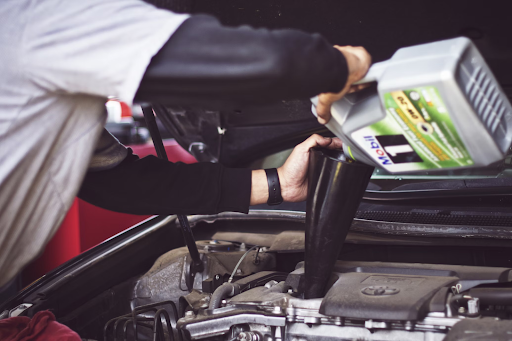
https://unsplash.com/photos/man-refilling-motor-oil-on-car-engine-bay-V37iTrYZz2E
Learning the basics of auto maintenance is essential for every student who owns or uses a car regularly. Understanding the car parts and components better and how to maintain materials is very important to keep the car running. Furthermore, periodically maintaining your vehicle saves much money compared to letting other mechanics fix your car. Mario Andretti, a racing driver, once said, “If everything seems under control, you’re just not going fast enough.” It means you always need services, even if things seem under our control. Let’s explore a list of essential car maintenance services.
1. Checking and Changing Oil
It is imperative to check and change your car oil at fixed intervals to maintain your car. Engine oil is essential for the optimal health of an engine, as it lubricates the moving parts of the engine, which prevents spontaneous failure in the form of overheating and rapid wear-and-tear because of friction. Check your engineís oil level with the oil-dip stick and know the kind of engine oil that corresponds to your vehicleís make and model; the angle of your dipstick will depend on whether the oilís levels have gone up or down, which will tell you when and how much oil to add. Check your car’s manual for specific details.
Picture maintaining your car. You want to be able to drive it carefree year after year. In the same way, using special writing services helps a student achieve academic success. Learners can pay for reseach paper at academized to complete their academic tasks to a high standard, just as regular car maintenance ensures that the vehicle runs reliably. This strategy saves time and allows students to focus on learning practical skills, like car maintenance, that are vital outside the classroom.
2. Replacing Windshield Wipers
Visibility and safe driving go hand in hand. Winter storms and rainy weather can require you to turn on your windshield wipers. Over time, the rubber wiper blades can start to wear and dry out, depositing streaks and smears on your windshield that can obscure your view and impair your ability to see and drive safely. Knowing how to check your wiper blades (parts of a vehicle that clean the windshield to improve visibility) and how to replace them can help ensure you always have a clear view of the road.
3. Monitoring Tire Pressure and Tread
Your tires are the only part of your car that makes contact with the earth – they must be looked after. And when it comes to tire care, there’s none more critical than tire pressure. Keeping the pressure right keeps you safe and ensures that you get the best fuel economy from your car and the most extended life for your tires. According to the U.S. Department of Energy, drivers can improve fuel economy by up to 3.3% by keeping tires inflated at the correct pressure. It has long been shown that, by overinflating or underinflating your tires, you can cause premature tire wear – a problem that you’ll then spend $400 to $800 replacing, depending on your car. You should also check your tire tread occasionally to ensure they are worn only within the permitted limits.
4. Understanding Dashboard Indicators
There are indicators on your car dashboard that can warn you of a problem. Learn the meaning of the most common indicators on your dash. The table below represents some common dashboard indicators and means in your car:
| Engine Light | Signals a variety of engine issues that could be minor or serious. |
| Oil Pressure | Indicates low oil pressure, which could lead to engine damage if ignored. |
| Battery | It warns of problems with failing or discharged batteries or car charging systems. |
| Temperature | It shows that the engine is overheating; this requires immediate attention to prevent severe damage. |
| Tire Pressure | Warning if the inflation pressure in one or more tires is too low or too high. |
Knowing these signs can help you identify and address potential problems before they lead to more severe damage.
5. Replacing Air Filters
Keeping up with this task will help keep your car running efficiently and for many miles to come. When air freely flows over the intake, an engine can be more fuel efficient and emit less air pollutants, as fuel resources are typically combusted better. Fortunately, an air filter is pretty easy to replace: in most cars, it’s located under the hood in a housing fastened to the engine with clips or screws. Your owner’s manual should tell you exactly where to find it and how to remove and replace it. Most manufacturers recommend changing air filters every 12,000 to 15,000 miles driven, but if you live in a particularly dusty or high-pollen environment, you might need to do it more often. Ensuring the air filters are changed regularly improves engine efficiency and keeps the vehicle healthy. Replacing them will save money in the long run because excessive use can lead to more expensive engine repairs. This simple upkeep can keep the engine car purring for a long time.
6. Jump-Starting a Car
A dead battery can have you stuck in the most unexpected place. But you can remedy knowing how to jump-start your car. Learning to jump-start a vehicle and the proper way to hook up jumper cables is quite simple: first, hook up the positive cable to the positive terminal of your dead battery and then to your donor battery’s positive terminal. Then, hook up the last terminal, the negative cable, to your donor battery’s negative terminal. Don’t hook it up to your engine block until the previous step to avoid sparking. And, of course, follow all the safety precautions: don’t get any jumper cables or tools near combustion areas, and keep your hands away from the switches under door frames. Keep a good set of jumper cables in your car’s emergency kit. You never know when you’ll need to jump-start your vehicle. It can come in handy in an emergency and save you from waiting a long time for a tow truck.
7. Basic Cleaning and Upkeep
We drive and park in a variety of situations. It means regular cleaning and maintenance of your car is essential not only for comfort and safety but also for the longevity of your vehicle – and your investment. This passage lists some of the tasks you should be doing occasionally.
- Washing: Wait to wash your car to keep the paint from rusting or getting damaged by dirt.
- Vacuuming: Clean your car’s interior by vacuuming carpets and seats to remove dirt and debris.
- Wipe Surfaces: Wipe the dashboard, steering wheel, etc. Keep surfaces clean and hygienic.
- Waxing: Applying a layer of wax after cleaning will not only prevent stains but also leave the car glistening.
Every time you perform this sort of maintenance, year in and year out, you improve your car’s look and helpful life, keeping it comfortable and valuable for the road ahead.
Conclusion: Empowerment Through Knowledge
If you learn these skills, you will take better care of your car, stay reliable, and perform well for longer. Besides, you will feel more independent and self-confident when your car gives you a hard time. Not least, you will save a fortune on maintenance and repairs, which is always a relief for students. Take the time to learn these skills – your car and purse will be grateful.





More Stories
Why You Should Invest in Regular Car Washes to Protect Your Investment
Workers’ Compensation for Repetitive Stress Injuries
The Effective Ways to Deal With the Rising Problem of Car Accidents